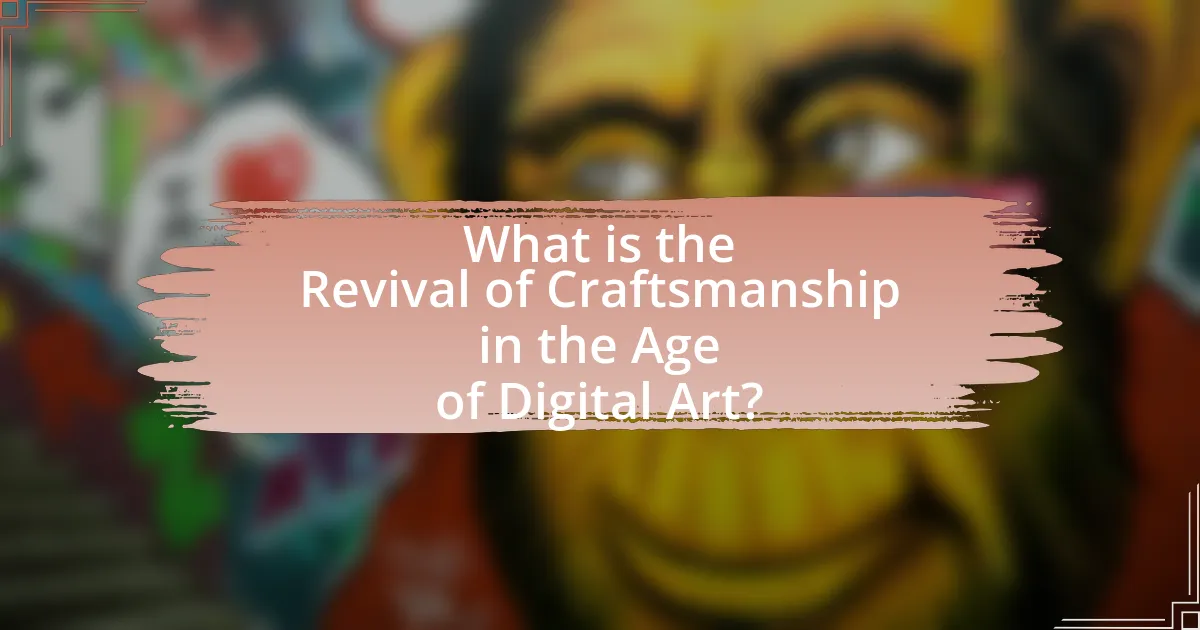The article explores the Revival of Craftsmanship in the Age of Digital Art, highlighting the renewed interest in traditional artisanal skills within a digital landscape. It examines how digital tools influence traditional craftsmanship, emphasizing characteristics such as attention to detail and quality over quantity. The piece discusses the integration of digital technologies by artisans, the growing consumer demand for authenticity, and the cultural factors driving this movement. Additionally, it addresses the challenges craftsmen face in adapting to modern technologies while maintaining their unique identities and offers insights into the future prospects for craftsmanship in an increasingly digital world.

What is the Revival of Craftsmanship in the Age of Digital Art?
The Revival of Craftsmanship in the Age of Digital Art refers to the renewed interest and appreciation for traditional artisanal skills and handmade techniques in a predominantly digital landscape. This movement is characterized by artists and creators who blend digital tools with traditional craftsmanship, emphasizing quality, authenticity, and the tactile experience of art. Evidence of this revival can be seen in the rise of maker culture, where individuals engage in hands-on creation, and in the popularity of artisanal products that prioritize craftsmanship over mass production. Additionally, exhibitions and platforms that showcase handcrafted works alongside digital art highlight the coexistence and synergy between these two realms, reinforcing the value of craftsmanship in contemporary artistic expression.
How has digital art influenced traditional craftsmanship?
Digital art has significantly influenced traditional craftsmanship by integrating technology into creative processes, enhancing both accessibility and innovation. Traditional artisans now utilize digital tools such as graphic design software and 3D printing to expand their creative possibilities, allowing for more intricate designs and faster production methods. For instance, the use of digital fabrication techniques has enabled craftsmen to create complex forms that would be difficult to achieve by hand, thus merging traditional skills with modern technology. This fusion not only preserves traditional techniques but also revitalizes them, attracting a new generation of artists and consumers interested in unique, handcrafted items that incorporate contemporary aesthetics.
What are the key characteristics of craftsmanship that are being revived?
The key characteristics of craftsmanship that are being revived include attention to detail, traditional techniques, and a focus on quality over quantity. Attention to detail emphasizes precision and care in the creation process, which is increasingly valued in a world dominated by mass production. Traditional techniques, often passed down through generations, are being rediscovered as artisans seek to connect with historical practices and cultural heritage. Additionally, the focus on quality over quantity reflects a growing consumer preference for unique, handmade items that offer authenticity and durability, contrasting sharply with the disposable nature of digital art and mass-manufactured goods.
How do artisans integrate digital tools into their craft?
Artisans integrate digital tools into their craft by utilizing software for design, digital fabrication techniques, and online platforms for marketing and sales. For instance, many artisans use computer-aided design (CAD) software to create precise designs, which can then be translated into physical products using 3D printing or CNC machining. This integration allows for greater accuracy and efficiency in the crafting process. Additionally, artisans leverage social media and e-commerce platforms to reach wider audiences, showcasing their work and facilitating sales directly to consumers. This shift not only enhances their creative capabilities but also expands their market reach, demonstrating the significant impact of digital tools on traditional craftsmanship.
Why is there a growing interest in craftsmanship today?
There is a growing interest in craftsmanship today due to a desire for authenticity and uniqueness in a world dominated by mass production. Consumers increasingly seek handmade, artisanal products that reflect personal values and stories, contrasting with the uniformity of digital and factory-made items. This trend is supported by a rise in platforms that promote local artisans and craftspeople, allowing them to reach wider audiences. Additionally, studies show that 78% of consumers prefer to buy from brands that demonstrate a commitment to craftsmanship and quality, highlighting a shift towards valuing skill and tradition over convenience.
What cultural factors contribute to the revival of craftsmanship?
Cultural factors contributing to the revival of craftsmanship include a growing appreciation for authenticity, sustainability, and the desire for unique, handmade products. This shift is driven by consumer awareness of mass production’s environmental impact and a longing for personal connection to the items they purchase. For instance, a 2021 survey by the Craft Council found that 70% of respondents prefer handmade goods over mass-produced items, indicating a strong market demand for craftsmanship. Additionally, social media platforms have enabled artisans to showcase their work, fostering a community that values traditional skills and techniques, further enhancing the cultural significance of craftsmanship in contemporary society.
How does the desire for authenticity drive this movement?
The desire for authenticity drives the revival of craftsmanship by fostering a preference for handmade, unique products over mass-produced items. This movement reflects a growing consumer demand for genuine experiences and tangible connections to the creators, as evidenced by the rise in popularity of artisanal goods and local craftspeople. According to a 2021 survey by the Craft Industry Alliance, 70% of consumers expressed a preference for purchasing handmade items, highlighting the value placed on authenticity in a digital age dominated by uniformity.

What are the challenges faced by craftsmen in the digital age?
Craftsmen in the digital age face several challenges, including competition from mass-produced goods, the need to adapt to new technologies, and the struggle to maintain traditional skills. The rise of e-commerce and digital platforms has made it easier for consumers to access cheaper, mass-produced alternatives, which can undermine the market for handcrafted items. Additionally, craftsmen must learn to use digital tools and software for design and marketing, which can be daunting for those accustomed to traditional methods. Maintaining the integrity of their craft while integrating modern techniques poses a significant challenge, as does the need to effectively communicate their unique value to consumers in a crowded marketplace.
How do digital technologies impact traditional crafting techniques?
Digital technologies significantly enhance traditional crafting techniques by introducing tools that improve precision, efficiency, and accessibility. For instance, computer-aided design (CAD) software allows artisans to create intricate designs with exact measurements, which can be challenging to achieve manually. Additionally, 3D printing technology enables the rapid prototyping of crafted items, allowing for experimentation and innovation without the extensive material waste associated with traditional methods. A study by the Crafts Council in the UK found that 70% of craftspeople reported that digital tools have positively influenced their creative process, demonstrating a clear integration of technology into traditional practices.
What skills are necessary for artisans to adapt to digital tools?
Artisans need technical proficiency, creativity, and adaptability to effectively adapt to digital tools. Technical proficiency involves understanding software and hardware relevant to their craft, such as design software for digital fabrication or online platforms for marketing. Creativity is essential for integrating traditional craftsmanship with digital techniques, allowing artisans to innovate and enhance their work. Adaptability is crucial as artisans must be willing to learn and embrace new technologies, which can include 3D printing or digital design tools. These skills enable artisans to remain competitive and relevant in a rapidly evolving digital landscape.
How can craftsmen maintain their unique identity in a digital landscape?
Craftsmen can maintain their unique identity in a digital landscape by emphasizing their individual techniques and storytelling in their work. By showcasing the distinct processes and personal narratives behind their creations, craftsmen differentiate themselves from mass-produced items. For instance, artisans can utilize social media platforms to share videos and images that highlight their craftsmanship, thereby engaging audiences with the authenticity of their work. This approach not only fosters a personal connection with consumers but also reinforces the value of handmade items in a market saturated with digital art and mass production.
What role do communities play in supporting craftsmanship?
Communities play a crucial role in supporting craftsmanship by fostering collaboration, providing resources, and creating networks for artisans. These social structures enable craftsmen to share skills, techniques, and knowledge, which enhances the quality and diversity of their work. For instance, local workshops and maker spaces often serve as hubs where artisans can access tools and materials, collaborate on projects, and participate in training sessions. Additionally, community events such as craft fairs and exhibitions promote visibility for artisans, allowing them to reach wider audiences and gain recognition. This support is evidenced by the growth of artisan markets, which have seen a 20% increase in participation over the past five years, highlighting the demand for handcrafted goods and the community’s role in sustaining this revival.
How do local and online communities foster collaboration among artisans?
Local and online communities foster collaboration among artisans by providing platforms for sharing resources, skills, and ideas. These communities enable artisans to connect, collaborate on projects, and exchange knowledge, which enhances their craftsmanship. For instance, local artisan groups often organize workshops and events that encourage hands-on collaboration, while online platforms like social media and dedicated forums allow artisans to showcase their work, seek feedback, and collaborate across geographical boundaries. Research indicates that such collaborative environments can lead to increased innovation and creativity, as artisans benefit from diverse perspectives and shared experiences.
What resources are available for craftsmen to enhance their skills?
Craftsmen can enhance their skills through various resources, including online courses, workshops, mentorship programs, and community organizations. Online platforms like Skillshare and Udemy offer specialized courses in different crafts, allowing artisans to learn at their own pace. Workshops conducted by local artisans or craft schools provide hands-on experience and direct feedback. Mentorship programs connect less experienced craftsmen with seasoned professionals, fostering skill development through guidance. Additionally, community organizations often host events and classes that promote craftsmanship, creating opportunities for networking and collaboration. These resources collectively support skill enhancement in the evolving landscape of craftsmanship.

What are the future prospects for craftsmanship in the digital era?
The future prospects for craftsmanship in the digital era are promising, as technology enhances traditional skills while fostering new forms of creative expression. Digital tools such as 3D printing, virtual reality, and design software allow artisans to innovate and reach broader audiences, thereby revitalizing interest in handcrafted goods. For instance, a report by the Crafts Council in the UK indicates that the craft sector has seen a 20% increase in revenue over the past five years, driven by online sales and digital marketing strategies. This trend suggests that craftsmanship can thrive alongside digital advancements, merging traditional techniques with modern technology to create unique products that appeal to contemporary consumers.
How can craftsmanship evolve alongside technological advancements?
Craftsmanship can evolve alongside technological advancements by integrating digital tools and techniques into traditional practices. For instance, artisans can utilize computer-aided design (CAD) software to enhance precision in their work, allowing for more intricate designs that were previously difficult to achieve by hand. Additionally, 3D printing technology enables craftsmen to create prototypes and final products with greater efficiency and reduced material waste, as evidenced by the rise of bespoke furniture makers who now incorporate 3D printing into their workflow. This fusion of technology and craftsmanship not only preserves traditional skills but also expands the creative possibilities available to artisans, ensuring their relevance in a rapidly changing market.
What innovations are emerging in the field of craftsmanship?
Innovations emerging in the field of craftsmanship include the integration of digital tools such as 3D printing, CNC machining, and augmented reality. These technologies enhance traditional techniques by allowing artisans to create intricate designs with precision and efficiency. For instance, 3D printing enables the production of complex shapes that would be difficult to achieve by hand, while CNC machines automate cutting processes, increasing accuracy and reducing labor time. Additionally, augmented reality applications assist craftsmen in visualizing their projects in real-time, improving design accuracy and client engagement. These advancements reflect a significant shift in craftsmanship, blending age-old skills with modern technology to expand creative possibilities and streamline production processes.
How can artisans leverage digital platforms for marketing and sales?
Artisans can leverage digital platforms for marketing and sales by utilizing social media, e-commerce websites, and online marketplaces to reach a broader audience. Social media platforms like Instagram and Facebook allow artisans to showcase their work visually, engage with potential customers, and build a community around their craft. E-commerce websites, such as Etsy or Shopify, provide artisans with the tools to set up online shops, manage inventory, and process transactions efficiently. Additionally, online marketplaces enable artisans to tap into existing customer bases, increasing visibility and sales opportunities. According to a 2021 report by Statista, e-commerce sales worldwide reached approximately $4.9 trillion, highlighting the significant potential for artisans to capitalize on digital platforms for their businesses.
What best practices can craftsmen adopt to thrive in the digital age?
Craftsmen can thrive in the digital age by embracing online platforms for marketing and sales, utilizing social media to showcase their work, and adopting digital tools for design and production. By leveraging e-commerce websites, craftsmen can reach a global audience, increasing their customer base significantly; for instance, platforms like Etsy have enabled artisans to sell directly to consumers, resulting in millions of transactions annually. Additionally, social media channels such as Instagram and Pinterest allow craftsmen to visually engage potential customers, with studies showing that 70% of consumers are influenced by social media in their purchasing decisions. Furthermore, integrating digital design software and tools can enhance craftsmanship efficiency and precision, as evidenced by the growing use of CAD (Computer-Aided Design) in various artisan fields, which streamlines the design process and reduces material waste.
How can artisans balance traditional techniques with modern technology?
Artisans can balance traditional techniques with modern technology by integrating digital tools into their creative processes while preserving the essence of their craftsmanship. For instance, artisans can use computer-aided design (CAD) software to enhance precision in their work, allowing them to create intricate designs that would be challenging to achieve by hand. This approach not only improves efficiency but also enables artisans to experiment with new forms and styles without losing their traditional skills.
Moreover, the use of modern technology, such as 3D printing, allows artisans to prototype their designs quickly, facilitating a blend of old and new methods. A study by the Crafts Council in the UK highlights that 70% of artisans who adopted digital tools reported an increase in their creative output, demonstrating that technology can complement rather than replace traditional craftsmanship. By embracing these technologies, artisans can reach broader markets and engage with a new generation of consumers who appreciate both heritage and innovation.
What strategies can be implemented to reach a wider audience?
To reach a wider audience, leveraging social media platforms is essential, as they provide access to diverse demographics and global reach. Social media channels like Instagram and Pinterest are particularly effective for showcasing craftsmanship visually, attracting users interested in art and handmade goods. According to a 2021 report by Statista, over 4.2 billion people use social media worldwide, highlighting its potential for audience expansion. Additionally, collaborating with influencers in the art and craftsmanship space can amplify visibility, as their established followers may be interested in similar content. Research from the Digital Marketing Institute indicates that influencer marketing can yield an ROI of up to 11 times the initial investment, further validating this strategy.


